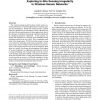943 search results - page 105 / 189 » Analysis of Enhanced Deployment Models for Sensor Networks |
CORR
2011
Springer
12 years 12 months ago
2011
Springer
Cellular networks are in a major transition from a carefully planned set of large tower-mounted basestations (BSs) to an irregular deployment of heterogeneous infrastructure eleme...
EUROGP
2005
Springer
14 years 1 months ago
2005
Springer
Abstract. Wireless sensor networks (WSNs) are medium scale manifestations of a paintable or amorphous computing paradigm. WSNs are becoming increasingly important as they attain gr...
IPSN
2004
Springer
14 years 1 months ago
2004
Springer
Automatic self-calibration of ad-hoc sensor networks is a critical need for their use in military or civilian applications. In general, self-calibration involves the combination o...
TPDS
2010
13 years 6 months ago
2010
The circular sensing model has been widely used to estimate performance of sensing applications in existing analysis and simulations. While this model provides valuable high-level...
SIGCOMM
2006
ACM
14 years 2 months ago
2006
ACM
Sensor networks are especially useful in catastrophic or emergency scenarios such as floods, fires, terrorist attacks or earthquakes where human participation may be too dangero...

